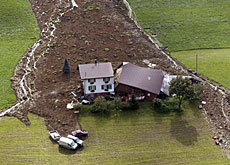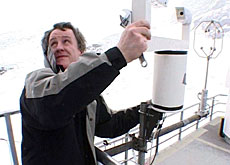Greenhouse gas makes its presence felt

A new type of greenhouse gas making its way through the atmosphere and spreading around the world could contribute to global warming, warn Swiss scientists.
Thanks to new technology, they have been able to track the spread of the compounds as far away as Australia.
The Jungfraujoch in the Bernese Alps. At about 3,500 metres above sea level you would expect the air to be fresh and clean.
But a measurement station perched on the ridge shows that the air at this rarefied altitude is in fact far from clean. The most recent example of pollution is the discovery of the first traces of two so-called foaming agents that belong to the family of hydrofluorocarbons (HFCs).
These compounds are the successors of chemicals that infamously attack the ozone layer and were banned under the 1987 Montreal Protocol – CFCs or chlorofluorocarbons. Chlorine-based CFCs were used in refrigerants, propellants, and cleaning solvents, but also to manufacture plastics and insulation materials.
The HFCs, which have been manufactured since 2002, have had little impact on air pollution, according to Martin Vollmer of the Federal Laboratories for Materials Testing and Research in Dübendorf near Zurich.
“Compared with CFCs, they are much better since they don’t contain chlorine or bromine and therefore don’t harm the ozone layer,” Vollmer told swissinfo.
He and his colleagues are pleased that they were able to detect these substances almost as soon as they appeared.
Finding the source
Thanks to a new, extremely sensitive measurement device, they are keeping up with the arrival of new chemicals instead of playing catch up as in the past.
“We knew that HFCs were being produced,” he said. “After a year or so we were able to see them in the atmosphere and follow their spread around the globe.”
The compounds were picked up in places as far away as Cape Grim in Tasmania as they circulated. But while this pollution is spreading far and wide, it also helps make modelling the global atmosphere simpler, according to Vollmer.
Up on the Jungfraujoch, the scientists have been able to determine the sources of the HFCs. For one compound, they were able to confirm that only one factory in eastern France was producing it.
Pointing at a diagram, Vollmer says another source seems to be Italy’s Po Valley. But no one there will confirm that they are producing HFCs.
“Every company I contacted denied they were the source of the pollution. These chemicals are not listed officially, but we have an idea where they might come from,” added Vollmer.
But producers of HFCs say their impact on the atmosphere is negligible. The Swiss researcher agrees that so far there is little to report, but warns there could problems on the road ahead.
Global warming threat
“They are typical greenhouse gases that contribute to global warming,” he told swissinfo.
“Depending on how much gets into the atmosphere, they could become quite a problem in the near future.”
For an equal weight, the two chemicals that were detected have a greenhouse effect 800 to 1,000 times stronger than that of carbon dioxide. Their levels have also steadily increased since the first measurements were carried out in 2002.
“If we add up all the HFCs, we will get maybe in a decade or so the levels of first and second-generation fluorocarbons, which were greenhouse gases too,” said Vollmer. “So it’s not negligible.”
swissinfo, Scott Capper in Dübendorf
HFCs are man-made chemicals, many of which have been developed as alternatives to ozone-depleting substances for industrial, commercial, and consumer products.
The atmospheric lifetime for HFCs varies from just over a year to 260 years.
Most of the commercially used compounds have atmospheric lifetimes of less than 15 years.
HFCs contain no chlorine. They are composed entirely of carbon, hydrogen, and fluorine.
They have currently a low global warming potential and have no known effects on the ozone layer. Only fluorine compounds containing chlorine and bromine are thought to harm the ozone layer. Fluorine itself is not ozone-toxic

In compliance with the JTI standards
More: SWI swissinfo.ch certified by the Journalism Trust Initiative











You can find an overview of ongoing debates with our journalists here . Please join us!
If you want to start a conversation about a topic raised in this article or want to report factual errors, email us at english@swissinfo.ch.